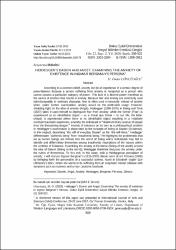| dc.contributor.author | Göncüoğlu, Mehmet Önder | |
| dc.date.accessioned | 2021-03-23T10:05:59Z | |
| dc.date.available | 2021-03-23T10:05:59Z | |
| dc.date.issued | 2020 | en_US |
| dc.identifier.citation | Göncüoğlu, M. Ö. (2020). Heidegger’s Dasein and Angst: Examining The anxiety of existence in Ingmar Bergman’s Persona. Dokuz Eylül Üniversitesi Sosyal Bilimler Enstitüsü Dergisi, 22 (2), 509-522. | en_US |
| dc.identifier.uri | http://dx.doi.org/10.16953/deusosbil.528178 | |
| dc.identifier.uri | https://hdl.handle.net/20.500.12809/9075 | |
| dc.description.abstract | According to a common belief, anxiety can be an experience of a certain degree of powerlessness because a person suffering from anxiety is hampered as a person who cannot possess a particular category of power. This lack of a desired power manifests as the source of emotion that results in anxiety. Because fear and anxiety are commonly used interchangeably in ordinary discourse, fear is often used erroneously instead of anxiety when, under further examination, anxiety would be the preferable usage. However, shedding light on the idea of anxiety (Angst), Heidegger (1889-1976) in Being and Time (1927) takes it upon himself to distinguish fear from anxiety: while the former (Fear) is experienced as an identifiable object -- as a threat qua threat -- to our life, the latter (Angst) is experienced where there is no identifiable object resulting in a relatively eventual traumatic experience, whereby the individual is “deprived of any avenue of escape from the threatening danger.” Anxiety of existence on its own as a philosophical problem in Heidegger’s examination is elaborated by the concepts of Being or Dasein (Existence). In this respect, describing ‘the self of everyday Dasein’ as the ‘the-self-there,’ Heidegger differentiates ‘authentic being’ from ‘inauthentic being.’ He highlights the problematic that we as human beings are thrown into the world of Being where individuals may fail to identify and differentiate themselves among inauthentic inscriptions of the masses within the confines of Existence. Examining the anxiety of Existence (Being of the world) around the idea of Dasein (Being in the world), Heidegger therefore discusses the anxiety under the rubric of thrownness. To this end, in this essay, with a Heideggerian perception of anxiety, I will discuss Ingmar Bergman’s (1918-2007) classic work of art Persona (1966) by bringing forth the personality of a successful actress, found in Elizabeth Vogler (Liv Ullmann)’s story, where she seems to be suffering from an enigmatic mental collapse with symptoms such as muteness and a near catatonic lassitude. | en_US |
| dc.description.abstract | Yaygın görüşe göre anksiyete bir tür güçsüzlük halidir. Bu kanıya göre anksiyete yaşayan kişi endişe durumunun üstesinden gelmesine yardımcı olacak iradi gücü elinde bulunduramamaktadır. Söz konusu bu gücün eksikliği bir duygu durumu olarak anksiyeteyi doğurmaktadır. Günlük hayatta korku ve anksiyete sıklıkla birbirlerinin yerine kullanılır. Ancak doğru bir analiz ile bu kullanımın yanlış olduğu, korkunun anksiyetinin yerine kullanılamayacak farklı bir anlam barındırdığı görülmektedir. Being and Time (1927) adlı çalışmasında anksiyeteyi korku kavramından ayıran Heidegger (1889-1976) korkuyu bir tehdit nesnesi varken yaşanan travmatik duygu durumu, anksiyeteyi ise herhangi bir tehdit unsuru olmadan yaşanan duygu durumu olarak açıklar. Anksiyete durumunda tehdit nesnesinin olmayışı yaşanan duygu durumunun da bertaraf edilmesini zorlaştırır. Varoluş anksiyetesi Heidegger için başlı başına felsefi bir problem olarak Being ve Dasein kavramları etrafında tartışılır. Oluş halinde bir kendilik olarak Dasein’ı ‘the-self-there’ olarak açıklayan Heidegger otantik oluşu otantik olmayan oluş’tan da ayırır. Dünyaya fırlatılmış varlıklar olduğumuzu ve bu nedenle varlık meselesinin önemli bir sorunu teşkil ettiğini söyleyen Heidegger, varlığın kendini yığınları oluşturan diğer otantik olmayan varlıklardan ayırmasının veya kendini otantik bir varlık olarak tanımasının da zorluğuna dikkat çeker. Varoluş anksiyetesini Dasein kavramı etrafında ele alan Heidegger anksiyeteyi esas olarak ‘atılmışlık’ düşüncesi etrafında tartışır. Bu çerçevede, bu çalışma Heideggerci anksiyete kavramı ekseninde Ingmar Bergman’ın (1918-2007) Persona isimli sinema eserini tartışmaktadır. Liv Ullman’ın başarılı oyunculuğuyla resmedilen Elizabeth Vogler karakteri Persona’daki anksiyete sorunsalını mental bir travmanın sepmtomları olarak katatonik bir sessizlik ve bezginlik olarak gösterir. | en_US |
| dc.item-language.iso | tur | en_US |
| dc.publisher | Dokuz Eylül Üniversitesi | en_US |
| dc.relation.isversionof | 10.16953/deusosbil.528178 | en_US |
| dc.item-rights | info:eu-repo/semantics/openAccess | en_US |
| dc.subject | Dasein | en_US |
| dc.subject | Angst | en_US |
| dc.subject | Anxiety | en_US |
| dc.subject | Heidegger | en_US |
| dc.subject | Bergman | en_US |
| dc.subject | Persona | en_US |
| dc.subject | Silence | en_US |
| dc.title | HEIDEGGER’S DASEIN AND ANGST: EXAMINING THE ANXIETY OF EXISTENCE IN INGMAR BERGMAN’S PERSONA | en_US |
| dc.item-title.alternative | HEIDEGGER’DE DASEIN VE ANGST: INGMAR BERGMAN’IN PERSONA’SINDA VAROLUŞ ANKSİYETESİ | en_US |
| dc.item-type | article | en_US |
| dc.contributor.department | MÜ, Edebiyat Fakültesi, Batı Dilleri ve Edebiyatları Bölümü | en_US |
| dc.contributor.authorID | 0000-0003-0738-453X | en_US |
| dc.contributor.institutionauthor | Göncüoğlu, Mehmet Önder | |
| dc.identifier.volume | 22 | en_US |
| dc.identifier.issue | 2 | en_US |
| dc.identifier.startpage | 509 | en_US |
| dc.identifier.endpage | 522 | en_US |
| dc.relation.journal | Dokuz Eylül Üniversitesi Sosyal Bilimler Enstitüsü Dergisi | en_US |
| dc.relation.publicationcategory | Makale - Uluslararası Hakemli Dergi - Kurum Öğretim Elemanı | en_US |


















